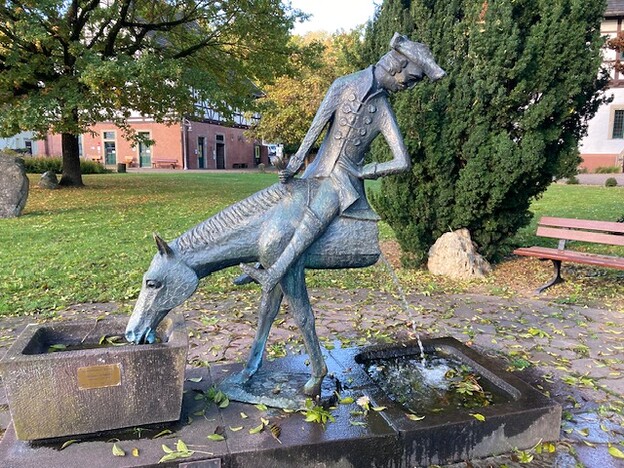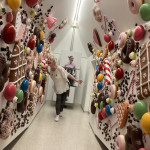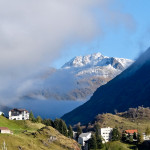Liz Gill travels the German Fairy Tale Route and Looks At Places Linked To The Brothers Grimm And The Stories They Collected
In the centre of Bremen there is a queue of people waiting to grasp the two front legs of the statue of a donkey, close their eyes and make a wish. So popular is the little chap that his legs have been polished by countless hands.
Perched on top of the donkey is a dog, on top of the dog is a cat and on top of the cat is a rooster. For these are the Animal Musicians of Bremen and the heroes of a story which, although almost unknown in the UK, is one of the most famous fairy tales across Europe.
Not far from the statue is a manhole type cover on the pavement which, if you drop a coin into it, produces either a bray, a bark, a miaow or a cock crow. Last year this attraction collected over £22,000 for local charities.

The story appeals because it tells of the importance of friendship and its ability to overcome danger and hardship, The animals meet up in old age when their owners have discarded them and go on to scare away a gang of robbers by each making the loudest noise possible before embarking on a successful new career performing in the city.
Its fame and popularity is due to the fact that the Brothers Grimm included it in their collection of stories along with those about Little Red Riding Hood, Snow White, Rapunzel, Cinderella and over 200 others.
Their achievements are celebrated with the 370-mile German Fairy Tale route which runs through places connected with the brothers – where they lived, studied and worked – or with the stories they published. Along the way visitors can encounter museums, galleries, guided tours, festivals, performances and meetings with costumed characters.
Bremen
I started in Bremen, a fascinating place in its own right: a small city with a big history. It was a medieval port, a major player in the Hanseatic League trading group, a centre of Christian mission ‘The Rome of the North’, an independent state granting freedom to its citizens and latterly an industrial giant.
Such was its importance as a maker of submarines and planes that the Allies bombed it 170 times during WWII. Nearly two thirds of the buildings were destroyed but the beautiful town hall was saved thanks to the fire-watching of teenage boys too young to fight. It is now the only town hall in the world to be designated a UNESCO World Heritage Site.


It also has a fine cathedral, an excellent art gallery – a current installation has 3,000 crystal-like LED lights turning it into a sparkling enchanted forest – and a wine store which offers around 1400 different German wines. I did a tour of the the 15th century cellar where the guide pointed out the oldest bottles from 1727. One of those would cost around £3000 so I contented myself with a tasting of scheurebe secco, the country’s answer to sauvignon blanc and a more modest tenner a bottle. Beer drinkers, of course, are well catered for in Germany. One restaurant on the journey offered a ‘a taster tray’ of five different ones.
Earlier I’d enjoyed Bremen’s mix of ancient and modern. I walked round the old area of Schnoor with its tightly packed houses, many with ‘owl holes’ – the owners wanted the vermin-catching birds to nest there – and others with no front doors – they were taxed – but with a ladder up to the first floor. The cobbled streets are now dotted with galleries, artisan workshops, cafes and restaurants.

This was followed by a trip down the Weser river past the Becks brewery from which the beer is exported to 180 countries and other major factories plus the curiosity of the now disused huge Kellogg’s building which in its heyday produced 500 tons of cornflakes a day.
It was into the river Weser that the the Pied Piper of Hameln, or Hamelin as we know it, led the rats which had plagued the city and who, when he was not given his agreed fee, returned to lead the children away.
On a previous visit I have followed a colourfully dressed Piper through the streets to hear about the legend that has intrigued millions since the Grimm Brothers wrote it down but this time our group only has time for a quick tootle before we set off to Bodenwerder, the home of the extraordinary Baron Hieronymus Karl Friedrich von Munchausen.
Big Mouth Baron in Bodenwerder
I had only heard the name in connection with the Munchausen Syndrome, so named by a British physician in the Fifties to describe those patients who made up or induced symptoms in themselves.
The real man though sounds to have been rather good fun: a teller of fabulously exaggerated tales with himself as the hero, told both to amuse his friends and to point up some serious moral or satirical message beneath the fantasies.
His real life had been eventful – sent as a young man to the Russian court he later fought in the Tsar’s army against the Ottomans in the Crimea– and many of his stories, created after he returned home to retire, have a military angle. One, for example, involves him riding a cannon ball, another sewing back together two halves of an injured horse. In a third he uses cherry stones after running out of shot during a hunt, only to find when he returns to the forest a year later that the stag now has a cherry tree growing out of its antlers.

The Baron never wrote his stories down: he was a strong believer in the oral tradition and rather disapproved of their being published. He certainly never made much money from their fame although the publisher did; within ten years they were translated into a hundred languages and nowadays the town has an annual prize for the German author who can concoct the most fantastic tales.
Pineapples – But Only For The Posh
The previous evening I’ve stayed at the similar sounding but differently spelled five-star Schlosshotel Munchhausen which dates back to the 16th century, and which has its own fantastic little story. It was here that the first pineapple was grown in Europe, a fruit so exotic that it became a symbol of great wealth: a single pineapple would have cost the equivalent of £3,000 in today’s money.
The German Fairytale Route is dotted with places which although they do not have a direct connection to the Brothers Grimm are worth a visit in their own right.

I stopped off at Hamelschenburg Castle, originally built with the gold and silver mercenaries earned in the newly discovered America but which later added an exquisite chapel which features a Crucifixion by Lucas Cranach.
On another day I explored Corvey Castle in Hoxter, a former Benedictine abbey, later a ducal home and now a UNESCO World Heritage Site. Its attractions include a baroque chapel, grand state rooms and a library with 75,000 volumes over 15 rooms. One of its librarians Hoffman von Fallersleben wrote the German national anthem.
Kiss The Girl in Gottingen
The last stop was Gottingen where the Brothers Grimm were professors at its distinguished university: it has produced 46 Nobel prize winners across all disciplines. Although it was the first in Europe to guarantee freedom from Church censorship its discipline was stern. It even had it own jail for students who fought, got drunk, made too much noise or rode a horse too fast. My guide points out though that a stint in there became a badge of honour: students who had not achieved one often tried to commit an offence in their final days.

A tradition that endures today is for newly graduated Ph.D students to be pulled through the streets in a decorated cart to the central square where they get out of the vehicle and go and kiss the Ganseliesel, the statue of a goosegirl. She can therefore claim, says the guide, to be the most kissed girl in the world
Tell Me More About The German Fairy Tale Route
Please visit German Fairy Tale Route for more information on the places Liz visited and more.
Bremen Tourism has plenty of information on the city
Visit Munchausen Museum for more information on Carl Friedrich Freiherr von Münchhausen.
Visit Gottingen for more information on the town






